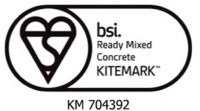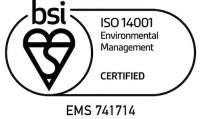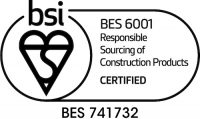Cement is a dry powder ingredient used to create concrete. Concrete is a building material made of aggregates, such as sand and stone, water and, most importantly, cement.
Cement usually makes up 10-15% of concrete. When mixed with water it forms a paste and then sets like stone giving concrete its impressive strength and durability.
Concrete is used for many different purposes, and each different application will require a different mix, or ratio of ingredients.
For example, concrete that is being poured into awkwardly shaped foundations will need to be more free-flowing (have a higher slump) to ensure it fills all the gaps. This means it will likely have a higher ratio of water to aggregate, and possibly also have a plasticiser added to the mix to give it better flow and workability.
There are three key ingredients in every type of concrete: water, cement and aggregate. The proportion or ratio of these ingredients will determine the type of concrete produced.
The aggregates used will also differ depending on the application of the concrete, for example, a smooth concrete screed will use a finer aggregate such as sand, while a more structural concrete might use stones and large gravel.
Additional materials can also be added to give the concrete different qualities, for example fibres to enhance strength, plasticisers for better workability or retarding agents to reduce the rate of setting.
No, concrete is a composite material.
However, the ingredients used to make concrete are often derived from different types of rock, such as the crushed limestone in cement, which makes the concrete set, and the aggregates such as granite, gravel and sand, which gives concrete its bulk and contributes to its strength.
Yes, concrete is a composite material made up of three key ingredients: water, cement and aggregate. The combination of materials is what gives concrete is resilience and strength, and the ratio of these materials will change depending on the type of concrete you want to produce.
You can also add additional materials to give your concrete extra qualities, such as retarding or accelerating agents to speed up or slow down the curing process.
Some types of concrete are better for the environment that others. For example, pervious or permeable concrete is more porous and so allows water to penetrate through. This reduces the risk of flooding from heavy rain and lets the water infiltrate the ground beneath for trees and plants to access. Also, some of the aggregates in concrete can come from recycled sources, such as rubble from demolitions, reducing the use of raw materials.
Although concrete sometimes has a bad reputation on the eco front, the strength, durability and longevity of concrete means it will very rarely need replacing or upgrading so its manufacture and production has a lower impact than some other materials.
When concrete structures are demolished or renovated, the concrete can be recycled at specialist facilities. Only clean concrete can be recycled, so any contaminates, such as trash, wood or plastic, will be taken out.
The concrete is then crushed and other recyclable materials are separated, for example metal rebar will be extracted and recycled separately. The remaining concrete rubble can then be used as hardcore, gravel and in the construction of new projects.
Some types of concrete, such as pervious or permeable concrete, is porous. This is produced using larger aggregates which allows water to seep through.
Porous concrete is often used in flatwork, such as car parks and residential streets, as it reduces water pooling on the surface. It is also used in low-impact developments, as it is more eco-friendly, reduces the likelihood of flooding and protects water quality.
Despite similarities, mortar and concrete are not the same. They are both widely used building materials, and are made of similar ingredients (cement, aggregate and water), but they are not interchangeable and have very different properties.
Mortar is usually made from sand aggregates, and is used to hold building materials together, such a in bricklaying, which is why it uses much more cement than concrete and has a much thicker consistency.
Concrete is a more structural material, usually composed of stone or gravel that gives it more strength and durability. This means it lasts longer and supports the structural integrity of buildings and foundations.
Most concrete is not completely waterproof. In order for it to have adequate workability most plant-batched concrete will be composed of more water than is required to simply set the cement. This excess water will dry out leaving very fine capillaries that can absorb water in the future.
However, there are types of concrete that are watertight, which means water does not flow through it, and damp proof, which means there will be no visible water ingress. For applications such as basement tanking or cellar conversions, specialist concrete can be batched to prevent dampness and flooding in the cellar.
Normal concrete can also be made waterproof with the application of a waterproof sealant or coating.
Calculating the exact amount of concrete you need to for a certain project can be tricky, but generally it will be a simple calculation of the width, length and thickness of the space.
The problem for most people is determining the type and thickness of the concrete required for a specific application. So to answer the question, you would need to be more specific, such as “how deep do my concrete footings need to be?” or “how thick should my garage bases be?”. The best thing to do is discuss your project’s individual requirements with an expert - the team at EasyMix are always happy to help.
The type of concrete you need will depend on a number of factors, such as the type of project, the ground conditions, the purpose of the structure, etc. There are various different types of concrete each designed for different applications to ensure the best results. Whether that be a standard C20 mix or a more specialist permeable mix with added plasticisers for workability.
Lightweight concrete is simply concrete that weighs less than standard concrete. It is used in construction to reduce the weight of a structure. This means the size of columns, footings and other load bearing components can also be reduced.
It is composed of lightweight aggregates (such as shale or slate) that usually have porous qualities, similar to volcanic rock, which makes the finished concrete lighter in weight, but still gives it plenty of strength.
LYTAG lightweight aggregate (LWA) is a specially designed aggregate, manufactured from fuel ash (pfa) to meet the requirements of modern concrete construction. It forms a lightweight concrete as the aggregate is half the weight of normal aggregates. It can also be used for concrete screeds and is ideal for drainage applications and bulk fill.
Volumetric concrete is the concrete produced by volumetric mixing trucks. These trucks carry the concrete ingredients on board and mix the concrete on site for immediate delivery to the required location.
The benefits of volumetric concrete include being able to alter the batch for multiple applications on one site, carefully metered delivery so you only pay for what you use and and maximum workability time for each new batch produced.
Pouring concrete in the rain is sometimes inevitable, but it is important to remember that excess water compromises the strength of the concrete mix. You should ensure the cavity is as dry as possible and any large puddles or flooding are pumped out before concrete is poured.
Once your concrete is laid you should only remove excess water on the surface by ‘wiping’ it off with a hosepipe or a similar light instrument. Excess surface water should not be floated or brushed into the mix as it will cause a weak, crumbly surface.
Please remember our advice should always be checked with a professional builder who has first hand experience with your particular requirements.
You can pour concrete in cold weather conditions, but the colder it is the longer it will take to properly cure. You must not allow ice to form in your concrete, if the water in your concrete mix freezes it will not create the chemical reaction necessary for curing the cement and will compromise the concrete’s strength.
You should never pour concrete directly onto snow or frozen ground. All snow, ice and pooled water should be removed before pouring. It is a good idea to do this the day before and cover the ground over with polythene to try and raise the temperature before pouring.
It is impossible to guarantee no cracks will appear in new concrete, however you can take steps to avoid it:
- Ensure you use the right amount of water. Too much and as the concrete cures and dries, it will shrink and crack. Too little and the concrete cure too quickly, or not properly, resulting in cracks.
- Ensure you use the correct type and strength of concrete - the team at EasyMix will be happy to advise if you’re unsure.
- Do not pour concrete on frozen ground or snow, as the group will move as it thaws which could cause cracks.
- Ensure adequate control joints are installed to allow the concrete to shrink and expand with the weather.
There are many factors that could result in concrete cracking, the most common of which are:
- Too much or too little water in the concrete mix, resulting in improper curing (dries too quickly, or too slowly).
- Using the wrong grade or strength of concrete for the purpose, or exceeding its weight-bearing capabilities.
- Pouring concrete onto frozen ground, snow/ice or improperly prepared ground can result in the ground thawing or settling beneath the concrete.
- Incorrect placement of control joints, or no control joints added to allow the concrete to expand and shrink with the weather.
The thickness of concrete for a driveway is vital to its load bearing capacity, as is choosing the correct mix and strength of concrete. As a general rule we would say a standard residential driveway should be between 10cm and 16cm thick, depending on the type of vehicles that will use the driveway.
The best option is to speak to a member of the team at EasyMix and we’ll discuss your individual project, and help you find the most suitable solution for the best price. Please remember our advice should always be checked with a professional builder who has first hand experience with your particular requirements.
Installing a concrete slab base for a new shed or patio is usually the cheapest option to ensure a robust and stable foundation.
Ground conditions play a massive part in determining the type of concrete to use. As a general rule we would say a standard patio or shed, that will experience lightweight storage or use, should be a minimum of about 7.5cm thick. Although, walls, fence posts, etc, around the edge may need deeper foundation for support.
The best option is to speak to a member of the team at EasyMix and we’ll discuss your individual project, and help you find the most suitable solution for the best price.
Please remember our advice should always be checked with a professional builder who has first hand experience with your particular requirements.
Generally, and in accordance with building control guidance, concrete foundations for an extension of up to 2 storeys should be constructed at a minimum depth of 750-1000mm. Strip foundations should be a minimum width of 600mm and thickness of 225mm. Trench fill foundations should have a minimum width of 450mm and a minimum 500mm thickness of concrete.
That said, there are a lot of factors that could influence the depth of a concrete base for a home extension which could mean you would have to significantly adapt the above figures for the best results (these factors include the drainage system, any nearby trees, the ground conditions, etc.) So the best option is to contact the team at EasyMix to discuss your individual requirements. We’ll be happy to help you find the most suitable type and amount of concrete for your project.
Please remember our advice should always be checked with a professional builder who has first hand experience with your particular requirements.
We aim to deliver all our concrete in a 2 hour time slot, chosen at your convenience. For many customers, we can deliver on the same or next day, or you can order further in advance if you know the timeframe of your project.
The EasyMix concrete mixers need somewhere to park to deliver your concrete. The mixers are around 3 metres wide and 10 metres long, and if you’re also hiring a concrete pump, the space will need to be big enough to accommodate both vehicles - this is around 20m. The pumps allow us to access more remote locations, with pipes that will carry the concrete a maximum of 50m. It is possible to pump greater distances, please call us to discuss further.
Yes. Our concrete delivery mixers will deliver your required concrete all through London and some of the surrounding areas. We provide two wheelbarrows on each of our mixers, but you will need to have your own labourers on site ready to transport the concrete to the pour site. If you are unable to wheelbarrow the concrete then hiring our concrete pumps allows us to get as close as possible to your pour site. This is ideal if your site has access issues.
Throughout London and some of the surrounding areas. Our team will be happy to advise you over the phone, simply give us a call to find out more.
The EasyMix volumetric mixers produce concrete as you go, and are great for ensuring there is no ‘excess’ concrete - you only pay for what you use. Give us a call to find out more, and our team will be happy to offer expert advice on measuring and calculating the right amount concrete for the job.
Concrete pours do involve mess. All EasyMix Concrete vehicles carry pressure washers to help with clean up. We suggest you take precautions before a job starts to further decrease the amount of cleaning up after the concrete has been poured.
Some ways you can manage the mess include placing tarpaulin underneath the concrete mixer’s auger chute and the pump, taking extra care when transporting concrete via wheelbarrows and having a washout area available for the mixers once the pour has finished.
If you’re struggling to pick which concrete you need, check out our glossary of concrete types & their strengths. If you still need help, please get in touch with us today!



